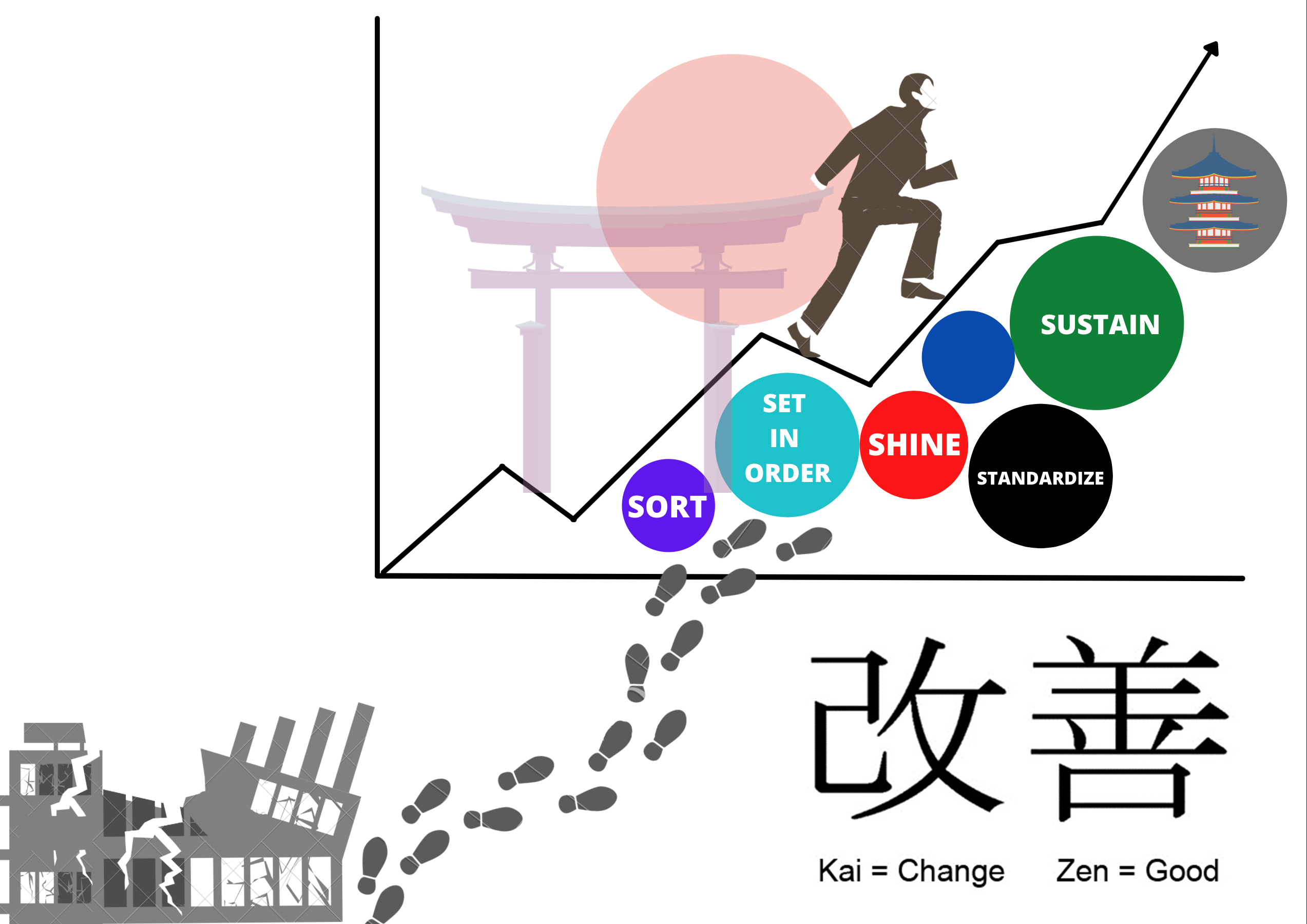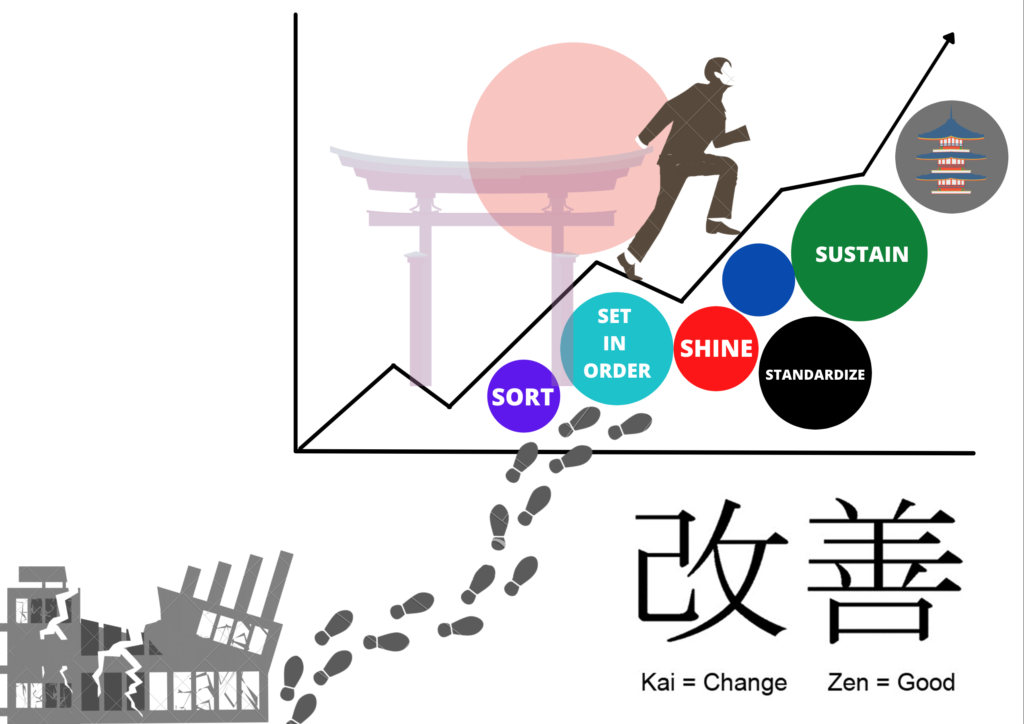World War II had recently taken place. Japan had been crippled, economically, socially and culturally. Due to rising geopolitical tensions with North Korea, The United States were invested in Japan’s quick economic recovery and had dispatched eminent and visionary business analysts and academic figures to help the Japanese with strategies for recovery. One of these was W. Edwards Deming. Deming believed in ‘Total Quality Management’ (TQM) which stated that improving on product quality would subsequently reduce expenses and increase productivity in the long term. This meant that industrial workers as well as their managers, both had to work together in tandem by solving a problem detected by workers immediately before moving forward. The Japanese further developed this technique to what we now know as “Kaizen”. They heavily used this technique in their industries. A prime example of this is the Toyota Production System (TPS), which was a last survival effort by the Toyota for its sustenance. Needless to say, the system worked brilliantly, empowered the workers and pushed other industries to adopt this method as well. By the 1980s, Japan had torn apart the post-war barriers and had the 2nd largest GDP in the world. Kaizen had caused an economic “miracle”. In 1986, Mr. Masaaki Imai introduced the West to the concepts of Kaizen that was based off the American TQM method via his best-selling book – ‘Kaizen, the key to Japan’s competitive success’. The wonders of the techniques described in the book were felt worldwide and people readily adopted them into their work and personal lives despite, there, existing other alternative methods. So, what really makes the Kaizen philosophy different and why did the world incline towards it?
CONTINUOUS IMPROVEMENT/CHANGE OR DIE?
In 2020, Netflix released a harrowing documentary called “The Social Dilemma” that discussed how our data gets ruthlessly exploited and manipulated by corporations. Now, ignoring the irony that the documentary was heavily discussed on digital social platforms and released on a social network itself, I remember how most of my friends and acquaintances (and I’m guessing you yourself or people you know too) had watched the documentary and suddenly fled the social media scene, promising that they would never come back in an attempt to detox themselves from the shackles of digital exploitation. But almost everyone that left social media “permanently” made it more like a hiatus and returned again within a week or less. Let’s analyze this by learning a little about our brain.
A primitive almond shaped part of our brain – The Amygdala is responsible for incredibly strong, negative emotions like pain, fear and anger. Often dubbed the old brain, its primary focus is survival. Thus, it activates reactions like the flight-or-fight response because of something called a “negativity bias” which arises due to our inner critic. On the other hand, a more complex part of our brain called the Prefrontal Cortex is responsible for a multitude of things, including cognitive control and reasoning. In the context of this article, this is the part of our brain that is responsible for us setting goals and thinking of long-term future plans and commitments.
Coming back to the situation at hand, it can be noted that people were presented with ‘Facts’ about the functioning of data-based corporations which threatened them and developed a ‘Fear’ for the situation. This fear made their Amygdala invoke their flight-or-fight response for survival (as it is trained to do), subsequently leading them to leave social media and try to make a change. However, this change couldn’t last very long since the motive for their change itself was based on something that was impermanent – Fear. Alan Deutschman calls this the 3F’s method (Facts, Fear and Force). He heavily talks about the inefficacy of this method since its mostly capable of producing temporary results which aren’t well motivated. Fear is one of the strongest human emotions, if not the strongest; and works spectacularly well to make quick, rapid decisions. However, once the ‘Fear’ dies down, people revert back to their old methods and habits. The essence of changing your habits is lost and the end result is also not achieved.
If you desire a more long-term change in your habits, you need your Prefrontal Cortex to actively work hard towards the change you want to see. You need to have a clear understanding of your current situation, define short-term target conditions and test out as to how close the method takes you to your goals. This process is extremely labor intensive. Deutschman thus suggests that we use the 3R’s technique instead which include – Relate, Repeat and Reframe. Finding a supportive peer group that has the same aims as you and repeating the small changes that you want to apply to your lives daily, helps change your narrative and transforms your changes into your habits. This is exactly the reason why groups such as Alcoholics Anonymous (AA) work so well.
ROME WASN’T BUILT IN A DAY:
Kaizen is a term coined from two Japanese words – ‘Kai’ meaning change and ‘Zen’ meaning good. Kaizen thus literally means ‘good change’. It preaches continuous improvement. Imai, in his book, states that ‘Our way of life – be it our working, social, or home life – deserves to be constantly improved.’
The philosophy of Kaizen isn’t about changing for the sake of change itself, but about identifying particular short-term and long-term goals and then taking small steps to achieve those goals. These small, incremental continuous steps towards short time goals eventually grow into something bigger and more powerful a result.
There is no particular “12 step program” towards Kaizen. However, the guiding principles of it include striving for continuous improvement, always questioning the traditional rules and making room for better one, not making excuses and instead focusing on finding solutions, and making continuous changes to your methods of development. Improvement is a dynamic process. If the plan you’ve made towards change feels ineffective, stop. Stop immediately and come up with a new action plan to go about things. Learning about what ‘does not work’ clarifies the parameters that are pivotal for change. The medial portion of the Prefrontal Cortex becomes active at this time and chips away at ideas that don’t work to reach towards something that might. For this, your Prefrontal Cortex must not be overwhelmed. We can thus say that the pre-requisite towards achieving Kaizen is decluttering your brain. Rid yourself of all the useless things around you and keep only what you believe is truly necessary. Minimalism is a key factor to having a decluttered mind and aids in making better informed, rational, non-impulsive decisions.

So why Kaizen?
The reason why Kaizen works, is because you make changes that are just so small that they don’t allow your Amygdala to trigger the flight-or-fight response. Psychologists such as Robert Maurer encourage the use of Kaizen techniques in our daily lives. Maurer says- ‘If the Amygdala is like an alarm system, small steps are like a cat burglar. Quietly, softly, and slowly, they pad past your fears. Your alarm never goes off.’ Making small steps forms new neural pathways before your fight-flight response or inner critic can be awakened. These small steps turn into habits and enable you to take more steps towards your development to give exponential outcomes. The beauty of this technique is that even if it’s widely used in business models, it can practically be applied to any sphere of life – Health, Work, Money, Home, Relationships, etc. It can especially be used in fields such as research due to its inherent scientific temperament of asking questions, getting to the root cause of an issue and changing test cases marginally to see how it would affect the resulting output.

Let’s take an example of applying Kaizen by using the problem of excessive phone usage. The first Kaizen step towards solving this could be downloading a detox app for a day and seeing if it changes your usage. Other small steps could include muting your notifications and deleting or reorganizing apps. I personally noticed that logging off on Instagram almost always made me log back in immediately. However, once I had deleted the app itself, the urge to be active on it had reduced considerably; this enabled me to use my time more productively to expand my skillset or work on my hobbies. Other steps that could be taken could include switching off your phones when you’re in a face-to-face conversation with someone. You have to understand that the purpose of these small changes is not to make you a social hermit but for you to be mindful of your usage. Instead of thinking of the bigger picture directly, which could sometimes be overwhelming, focus and trust the process. As long as you continually strive to make a difference every day using snail steps, change will undoubtedly take place.
Numerous companies across the world have inculcated Kaizen into their work culture which has directly incremented their growth. Japan, a country that was riddled with problems in every aspect of its existence after the world war, used this technique as a crutch to lean on and is now one of the biggest superpowers in the world. That by itself is a testament to the efficiency of Kaizen as a method. Every individual that applied the Kaizen philosophy has a success story. When will yours begin?
References
a) https://crm.org/articles/the-history-of-kaizen
b) https://www.gray.com/insights/why-the-brain-resists-continuous-improvement-what-you-can-do-about-it/
c) https://www.sciencedirect.com/topics/medicine-and-dentistry/prefrontal-cortex
d) https://blog.kainexus.com/improvement-disciplines/kaizen/the-neuroscience-of-kaizen
e) https://www.textiletoday.com.bd/self-improvement-kaizen-way/
f) https://www.projectengineer.net/how-to-implement-kaizen/
g) Kaizen, the key to Japan’s competitive success by Masaaki Imai
. . .
Writer

Tanya Gadwal
Tanya is currently pursuing B.Tech degree in Computer Science. She is interested in various forms of art and has a deep respect for the sciences. Her love for writing and science has coupled into an inclination towards science communication. Tanya says, “It would be fascinating to see how my science communication journey would progress in the future.”
Illustrators

Aishwarya Girish
Aishwarya is an undergraduate pursuing her degree in B.E Biotechnology from Ramaiah Institute of Technology, Bangalore.

Anushree Krishnamurthy
Co-founder, Director of Website Development and Logistics, The Science Paradox

